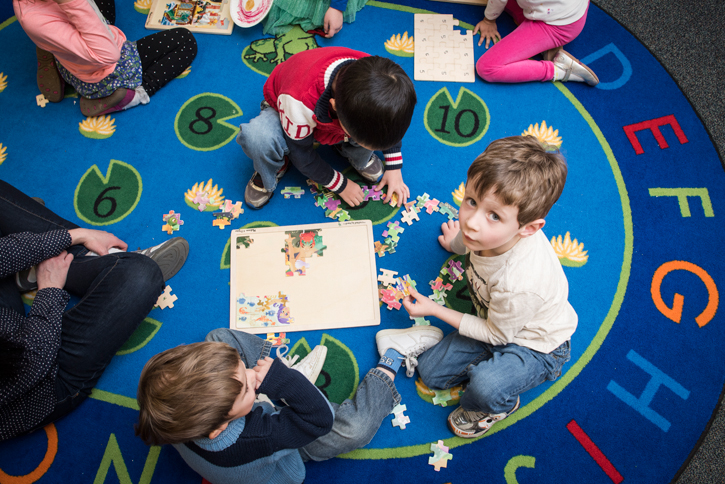
George Mason University's Child Development Center earned accreditation from the National Association for the Education of Young Children this year. Photo by Evan Cantwell.
Dorothea Tyree, lead teacher at George Mason University’s Child Development Center, will always remember the day she taught her students the Olympic motto—Faster, Higher, Stronger—in English and Latin.
She will remember because she soon after received a phone call from a student’s mother. The family was watching the television show “Jeopardy,” which asked about the translation of the Latin phrase.
“And the kid knew the English words,” Tyree recalled. “Whatever you expose them to, they’re like sponges.”
Tyree has worked for 16 years at the Child Development Center, which is open to children, ages 2-5, of George Mason faculty, staff and students. She was there when it was housed in a couple of trailers next to the Recreation and Athletic Complex.
So Tyree is understandably proud of the center’s evolution that includes a stand-alone facility and, as of May, a much sought-after accreditation from the National Association for the Education of Young Children. NAEYC is a professional membership organization which, its website says, works to promote high-quality early learning for all young children.
You can review its accreditation standards here.
“They’re really the gold standard of early childhood programs nationwide,” said Shira Kulok, the center’s director. “To get that, it not only states how much we value their standard and excellent quality care, it really speaks to the community about our program.”
The center’s program is play-based, Kulok said, but is still all about learning for the capacity enrollment of 104 children expected for the 2017-18 academic year. About 10 percent will be children of Mason students.
There is one teacher for every six 2-year-old students, and one teacher for every nine older students.
“In early childhood the idea is that play is a child’s work,” Kulok said. “Our job as educators is to set up an environment that allows children to explore freely and independently materials that excite the senses and challenge them, but also ones they can master with repetition.”
Such as manipulating a paintbrush or working with various paper sizes during an art workshop.
“The teacher really serves as a facilitator in that environment,” Kulok said, “asking very open-ended questions to help the child build upon the skills they are developing during play.”
Wendi Carroll, a life/work connections specialist in Mason’s Office of Human Resources and Payroll, saw the benefits in her son, Ryan, who attended the center from ages 2 to 5. In fact, Carroll said knowing the center was available to her child greatly impacted her decision to stay at Mason.
“Every day, he would say some random fact,” Wendi said of Ryan, “different things you didn’t expect a 2- or 3-year old to know.”
For example, Mercury is the closest planet to the sun.
“I said, ‘Where did you learn that?’ ” Wendi recalled. “He’d say, ‘I learned that in school, mom.’ ”
Sounds as though he is ready for “Jeopardy.”
